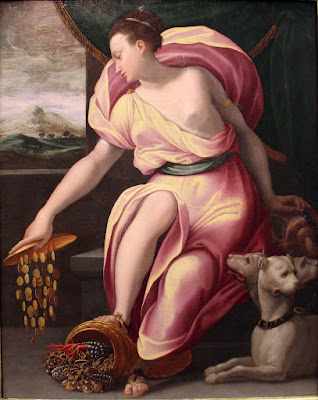 |
| Girolamo Macchietti Allegory of Prudence before 1592 oil on canvas Museo Collezione Gianfranco Luzzetti, Grosseto |
 |
| Girolamo Macchietti Adoration of the Magi (detail) 1568 oil on panel Basilica di San Lorenzo, Florence |
 |
| Girolamo Macchietti Adoration of the Magi 1568 oil on panel Basilica di San Lorenzo, Florence |
"A pupil of Michele di Ridolfo in his Vasarian phase, [Girolamo] Macchietti had then worked for six years (c. 1556-1562) in [Giorgio] Vasari's équipe in the Palazzo Vecchio. For this experience he found a partially effective antidote in two years' independent study in Rome. Returned to Florence, he formed a close but discontinuous connexion with the restless, brilliant Mirabello Cavalori, considerably older but destined to be short-lived. . . . The association with Vasari, an almost inescapable fact of the Florentine artistic economy of the time, should not disguise the difference from his brand of Maniera that Macchietti asserts in his early style. . . . The nature of Macchietti's dissent is apparent on a major scale in his Adoration of the Magi (Florence, S. Lorenzo, 1568), in which he tries, with a remarkable degree of success, to aggrandize the Vasarian Maniera according to the models – some of them observed in Rome – of the first generation of Maniera, conspicuously Parmigianino's. Handsome fullness of form, defined by generously rounding rhythms, recall the descent of contemporary Maniera from Raphael. Colour is changeant and continuously surprising, in the best vein of Florentine Maniera, but it is given resonance in chiaroscuro."
– S.J. Freedberg, Painting in Italy 1500-1600 in the Pelican History of Art series (1970)
"In his pictures for the Studiolo (Medea and Jason, The Baths of Pozzuoli) light takes on a more important role. These small panels show an elegance of shapes and rhythmic style that still more obviously depends on Parmigianino, but the forms exist in light – inspired, most probably, by Cavalori – that subtly and astonishingly conveys a truth of visual effect, surrounding artifice with credibility. Not just Parmigianino but the early Pontormo, who had sought similar effects, is recalled by Macchietti and exploited for this fine Mannerist ambivalence of purpose."
 |
| attributed to Girolamo Macchietti Allegory of Liberality before 1592 oil on canvas Galleria Giorgio Franchetti alla Ca' d'Oro, Venice |
 |
| attributed to Girolamo Macchietti Allegory of Liberality (detail) before 1592 oil on canvas Galleria Giorgio Franchetti alla Ca' d'Oro, Venice |
 |
| Girolamo Macchietti Portrait of a Lady ca. 1570 oil on canvas private collection |
 |
| Girolamo Macchietti Charity of St Nicholas of Bari ca. 1570 oil on canvas National Gallery, London |
 |
| Girolamo Macchietti Charity of St Nicholas of Bari (detail) ca. 1570 oil on canvas National Gallery, London |
 |
| Girolamo Macchietti Christ in Glory with St John the Baptist and St Catherine of Alexandria ca. 1562-68 drawing Galleria degli Uffizi, Florence |
 |
| Girolamo Macchietti Christ in Glory with St John the Baptist and St Catherine of Alexandria (Pala Lioni) ca. 1562-68 oil on canvas Villa Lioni-Michelozzi-Roti-Clavarino, Florence |
 |
| Girolamo Macchietti Study of Seated Model ca. 1560-70 drawing Metropolitan Museum of Art. New York |
 |
| Girolamo Macchietti St John the Baptist ca. 1568-76 drawing Metropolitan Museum of Art, New York |
 |
| Girolamo Macchietti St John the Baptist ca. 1568-76 oil on canvas (altarpiece fragment) Chiesa di San Michele Arcangelo, Empoli |
 |
| Girolamo Macchietti The Bath of Pozzuoli ca. 1570-73 oil on slate Studiolo di Francesco I, Palazzo Vecchio, Florence |
 |
| Girolamo Macchietti Medea and Jason ca. 1570-73 oil on canvas (installed on cabinet door) Studiolo di Francesco I, Palazzo Vecchio, Florence |
"In his pictures for the Studiolo (Medea and Jason, The Baths of Pozzuoli) light takes on a more important role. These small panels show an elegance of shapes and rhythmic style that still more obviously depends on Parmigianino, but the forms exist in light – inspired, most probably, by Cavalori – that subtly and astonishingly conveys a truth of visual effect, surrounding artifice with credibility. Not just Parmigianino but the early Pontormo, who had sought similar effects, is recalled by Macchietti and exploited for this fine Mannerist ambivalence of purpose."
– S.J. Freedberg, Painting in Italy 1500-1600 in the Pelican History of Art series (1970)